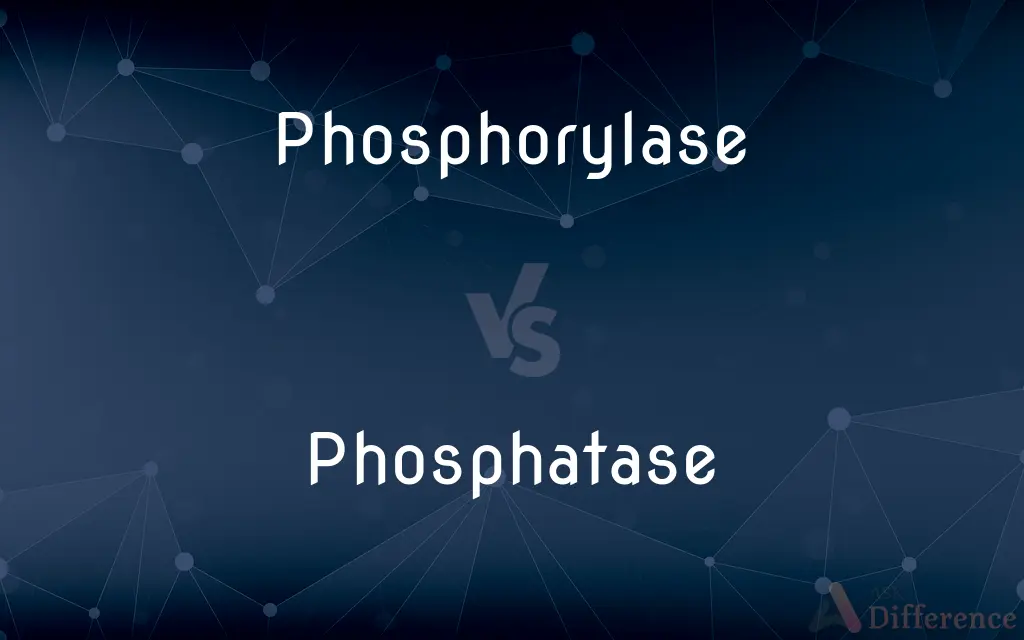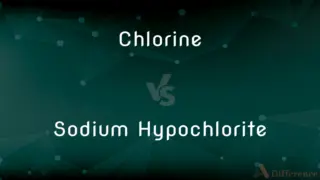Phosphorylase vs. Phosphatase — What's the Difference?
Edited by Tayyaba Rehman — By Fiza Rafique — Published on November 3, 2023
Phosphorylase adds a phosphate group to a substrate without ATP, while Phosphatase removes a phosphate group.

Difference Between Phosphorylase and Phosphatase
Table of Contents
ADVERTISEMENT
Key Differences
Phosphorylase and Phosphatase both partake actively in various biological processes. Phosphorylase facilitates the addition of a phosphate group to a substrate, often deriving the necessary phosphate from an inorganic source. In contrast, Phosphatase plays the opposite role by removing a phosphate group from a molecule, typically using water to facilitate the removal.
A comprehensive view into Phosphorylase and Phosphatase reveals their diverse roles in metabolic pathways. The former, Phosphorylase, acts essentially in pathways like glycogenolysis, enabling the breakdown of glycogen into glucose. Phosphatase, on the other hand, plays a pivotal role in dephosphorylation processes, thereby regulating enzymatic activities and signaling pathways.
Examining Phosphorylase and Phosphatase at a biochemical level further expands our understanding. Phosphorylase can, in some contexts, manipulate the energy status of a cell by regulating the availability of glucose. Alternatively, Phosphatase can modulate numerous pathways, adjusting cellular responses to changing conditions by altering the phosphorylation status of key proteins.
An additional layer of complexity in the Phosphorylase and Phosphatase dichotomy can be explored via their regulatory mechanisms. Various isoforms of Phosphorylase are intricately controlled by both allosteric regulators and by phosphorylation, while Phosphatase can be regulated through various means, including subcellular localization and expression levels.
Lastly, the structural and functional perspectives of Phosphorylase and Phosphatase should be underscored. Phosphorylase’s mechanism employs a pyridoxal phosphate cofactor to facilitate its reaction. Phosphatase, meanwhile, often utilizes a catalytic triad of amino acids to hydrolyze its substrate, exemplifying distinct enzymatic strategies.
ADVERTISEMENT
Comparison Chart
Function
Adds a phosphate group
Removes a phosphate group
Key Pathways
Involved in glycogenolysis
Involved in signal transduction pathways
Substrates
Typically acts on carbohydrates
Can act on a variety of phosphorylated molecules
Regulation
Regulated by allosteric mechanisms
Regulated by subcellular localization
Mechanism
Utilizes a pyridoxal phosphate cofactor
Often uses a catalytic amino acid triad
Compare with Definitions
Phosphorylase
Phosphorylase is an enzyme that adds a phosphate group to a substrate.
Glycogen phosphorylase catalyzes the release of glucose-1-phosphate from glycogen.
Phosphatase
Phosphatase is an enzyme that removes phosphate groups from its substrate.
Alkaline phosphatase dephosphorylates many types of molecules.
Phosphorylase
Phosphorylase utilizes a pyridoxal phosphate cofactor in its enzymatic action.
The pyridoxal phosphate in phosphorylase assists in breaking glycosidic bonds in glycogen.
Phosphatase
Phosphatase can play a role in modifying the physical properties of proteins.
Dephosphorylation by phosphatase can alter protein conformation and functionality.
Phosphorylase
Phosphorylase can be regulated by both allosteric and covalent means.
Phosphorylase b is converted into its more active form, phosphorylase a, via phosphorylation.
Phosphatase
Phosphatase operates in various cellular compartments to exert its function.
The enzyme phosphatase can work in the cytoplasm to regulate protein phosphorylation status.
Phosphorylase
Phosphorylase plays a crucial role in carbohydrate metabolism.
In the liver, phosphorylase facilitates the rapid release of glucose during fasting.
Phosphatase
Phosphatase functions using a water molecule to hydrolyze phosphoester bonds.
Protein phosphatases can revert the activity of kinases by removing phosphate groups from proteins.
Phosphorylase
Phosphorylase often operates without utilizing ATP.
The activation of phosphorylase in muscle cells does not directly consume ATP.
Phosphatase
Phosphatase is crucial in cellular signaling and regulatory pathways.
The action of phosphatase helps to regulate the MAPK signaling pathway.
Phosphorylase
Any of a class of enzymes that catalyze the attachment of a phosphate group to another molecule.
Phosphatase
Any of numerous enzymes that catalyze the removal of phosphate groups by hydrolysis of phosphate ester bonds. They act in the opposite manner to kinases and are important in metabolism and cell signaling.
Phosphorylase
(enzyme) Any enzyme that catalyzes the production of glucose phosphate from glycogen and inorganic phosphate
Phosphatase
(enzyme) Any of several enzymes that hydrolyze phosphate esters, and are important in the metabolism of carbohydrates, nucleotides and phospholipids, and in the formation of bone.
Phosphatase
Any of a group of enzymes that act as a catalyst in the hydrolysis of organic phosphates
Common Curiosities
In which biological processes is Phosphorylase primarily involved?
Phosphorylase is key in glycogenolysis, converting glycogen into glucose-1-phosphate.
What is the main function of Phosphatase?
Phosphatase removes a phosphate group from a molecule using a water molecule in the process (hydrolysis).
What is Phosphorylase?
Phosphorylase is an enzyme that adds a phosphate group to a substrate without the use of ATP.
Where does Phosphorylase get the phosphate group that it adds to substrates?
Phosphorylase typically obtains the phosphate group from inorganic phosphate, not from ATP.
Does Phosphorylase require a cofactor to function?
Yes, Phosphorylase often requires a pyridoxal phosphate as a cofactor to facilitate its enzymatic activity.
How does Phosphatase affect cellular signaling pathways?
Phosphatase can deactivate or alter signaling pathways by removing phosphate groups from molecules, impacting signal transduction.
What is the significance of Phosphatase in metabolic regulation?
Phosphatase can regulate metabolic pathways by altering the phosphorylation state of metabolic enzymes, impacting their activity.
Are there different types of Phosphorylase and Phosphatase?
Yes, both Phosphorylase and Phosphatase have multiple isoforms and types that may have specific substrates and regulation.
Are Phosphorylase and Phosphatase antagonistic in their actions?
Yes, typically, Phosphorylase adds phosphate groups, while Phosphatase removes them, often counteracting each other’s actions.
How do Phosphorylase and Phosphatase relate to energy balance?
Phosphorylase can release glucose for energy production, while Phosphatase can regulate energy pathways by modifying enzyme activity.
Can Phosphatase activity be measured?
Yes, Phosphatase activity is often measured using specific biochemical assays that detect the release of free phosphate.
Is Phosphatase specific to certain types of molecules?
No, Phosphatase can act on a variety of molecules, including proteins, nucleotides, and carbohydrates, among others.
What is glycogen Phosphorylase?
Glycogen Phosphorylase is a type of Phosphorylase that breaks down glycogen into glucose-1-phosphate.
What regulates Phosphorylase activity?
Phosphorylase activity can be regulated by allosteric modulators and covalent modification, such as phosphorylation.
How does Phosphatase contribute to disease states?
Abnormal Phosphatase activity can dysregulate cellular signaling and metabolic pathways, potentially contributing to various diseases, including cancer and metabolic disorders.
Share Your Discovery

Previous Comparison
Educational Management vs. Educational Administration
Next Comparison
Chlorine vs. Sodium HypochloriteAuthor Spotlight
Written by
Fiza RafiqueFiza Rafique is a skilled content writer at AskDifference.com, where she meticulously refines and enhances written pieces. Drawing from her vast editorial expertise, Fiza ensures clarity, accuracy, and precision in every article. Passionate about language, she continually seeks to elevate the quality of content for readers worldwide.
Edited by
Tayyaba RehmanTayyaba Rehman is a distinguished writer, currently serving as a primary contributor to askdifference.com. As a researcher in semantics and etymology, Tayyaba's passion for the complexity of languages and their distinctions has found a perfect home on the platform. Tayyaba delves into the intricacies of language, distinguishing between commonly confused words and phrases, thereby providing clarity for readers worldwide.












































